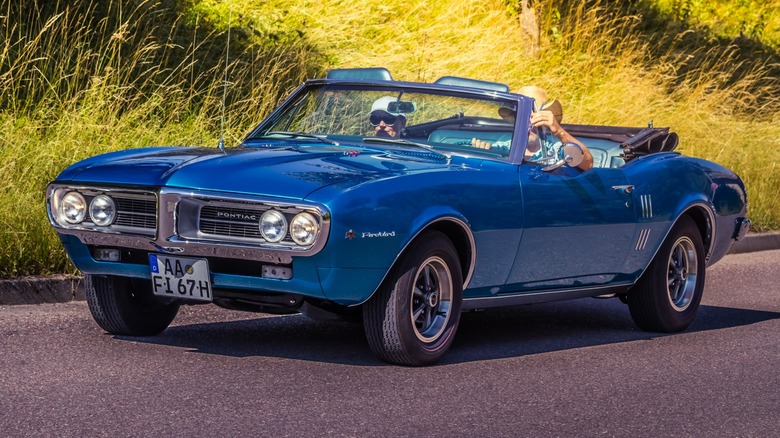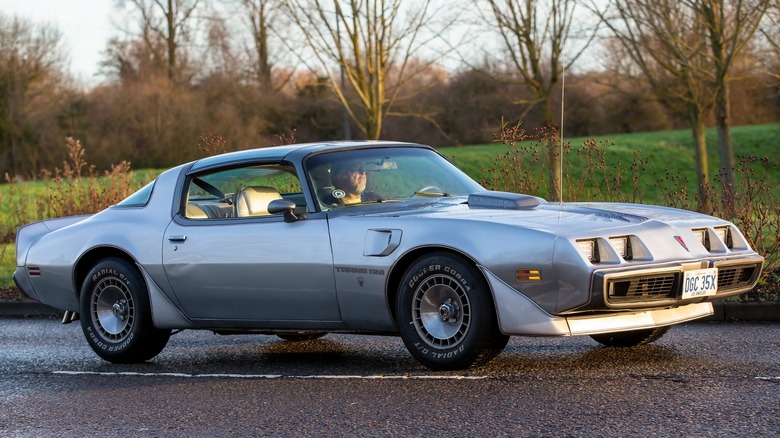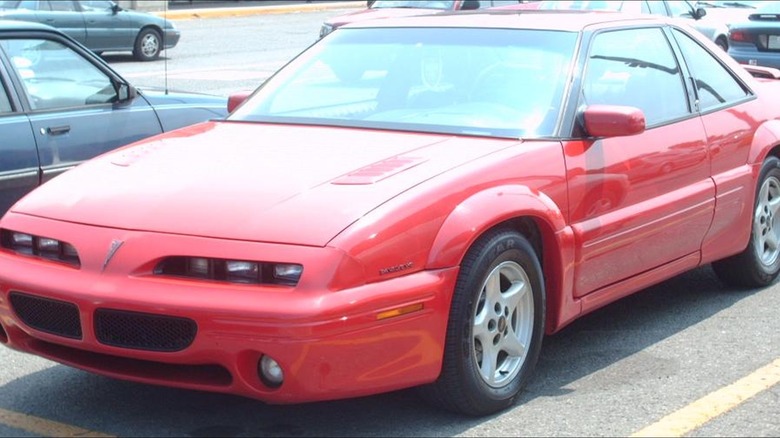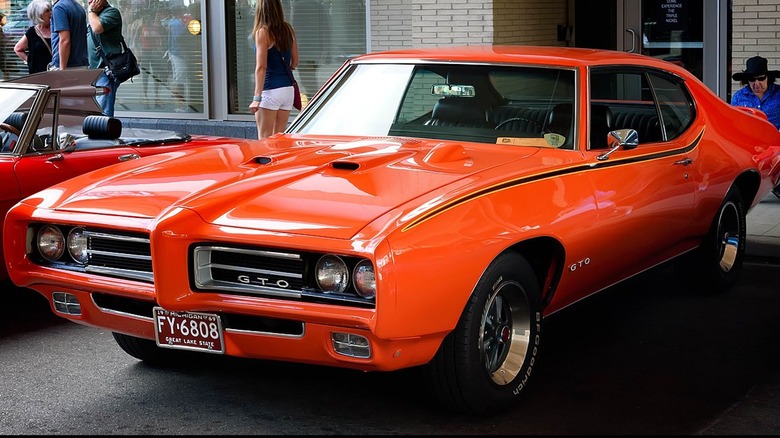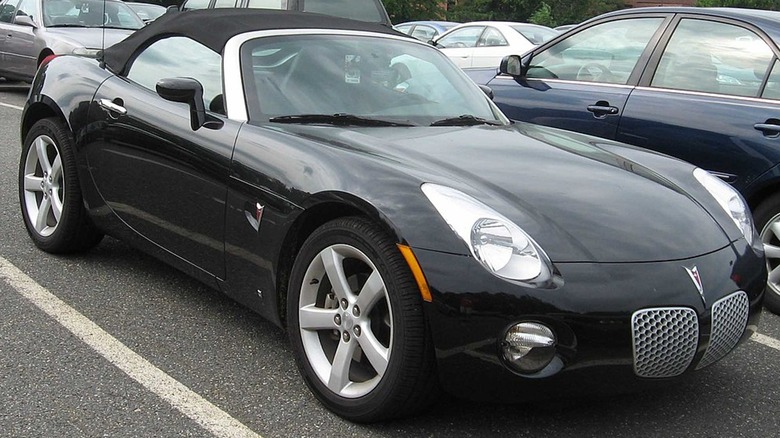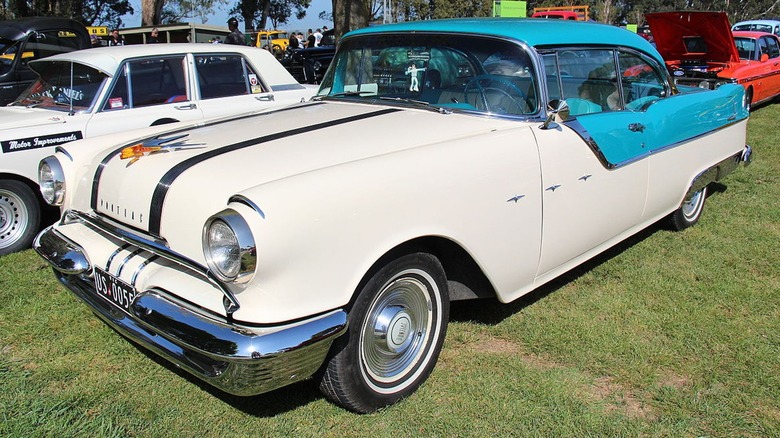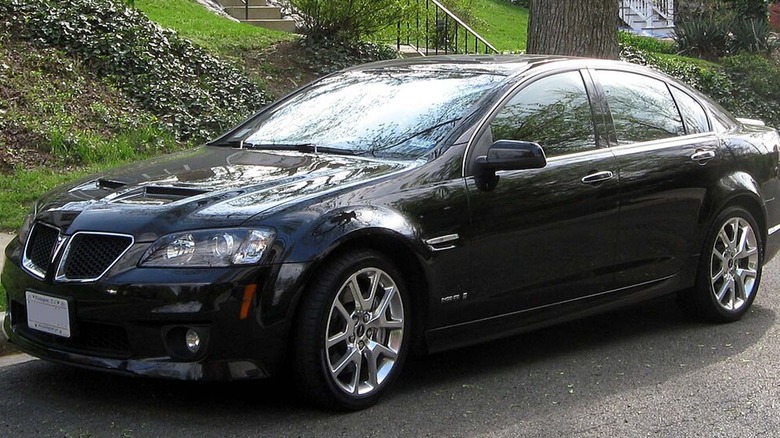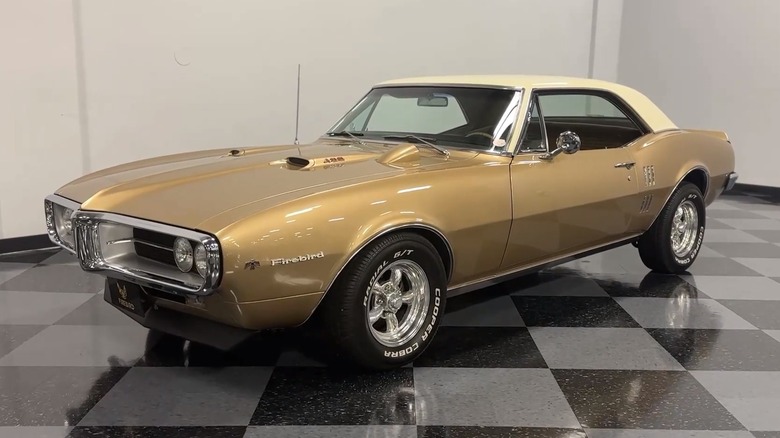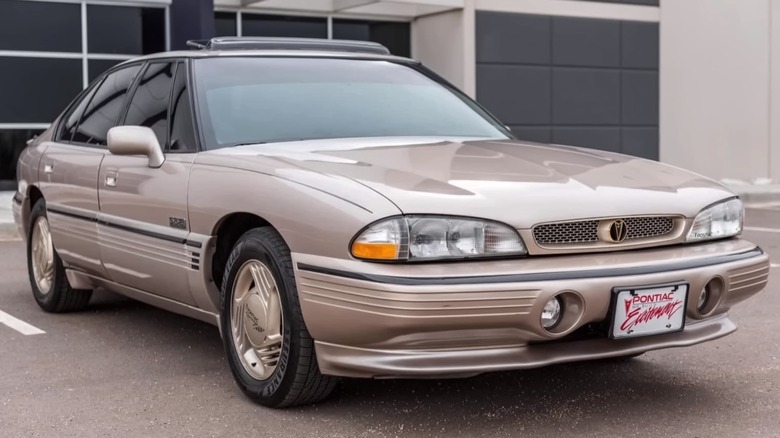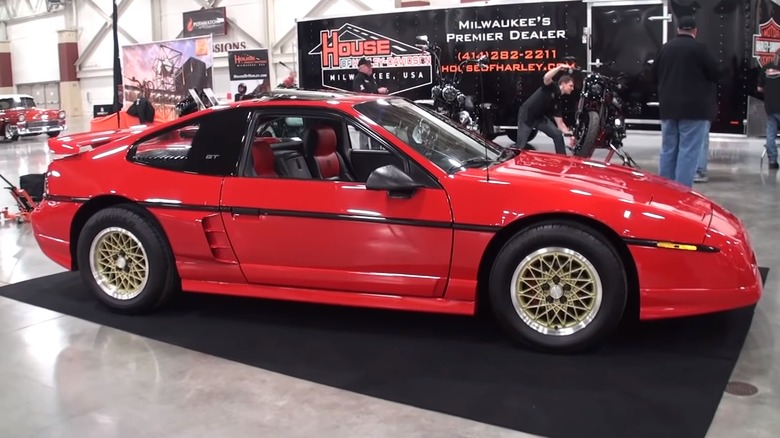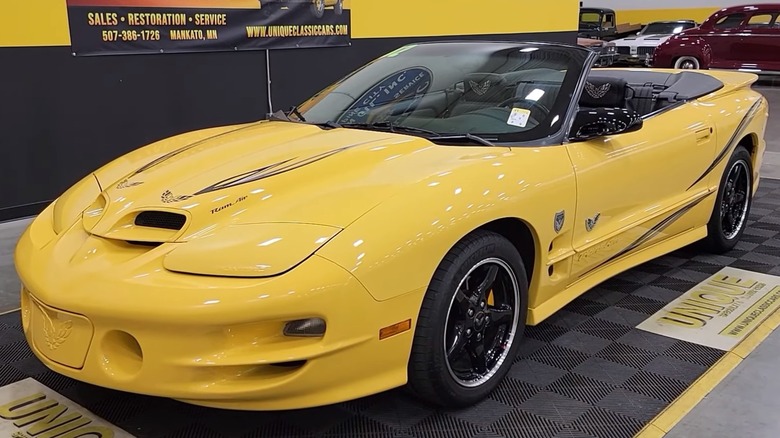10 Of The Coolest Looking Pontiac Models Ever Made
Named for a Michigan-area Indian chief who once led a failed rebellion against the British, Pontiac was created by General Motors in 1926 and built cars for the middle class for 83 years until it was unceremoniously axed in 2009 during the Great Recession. During those decades of Pontiac manufacturing, the company built a wide range of desirable — and plenty that are not so desirable — automobiles priced to be an aspirational brand for the Chevrolet buyer. They were no luxury cars but they were not economy cars either. Pontiacs were an affordable choice for middle-class folks who had a little extra to spend.
Big changes came to Pontiac in the 1960s when a young executive with lots of ideas became in charge. John DeLorean set Pontiac on a course in which the name would be synonymous with performance until the end. Some of the most cherished classic cars came from his era and these made it possible for even more to come later. While some may lament that the Pontiac Motor Division is no more, there's plenty to appreciate among the long list of stylish and attractive cars from Pontiac's assembly lines. Here are the coolest-looking models ever built by the Detroit automaker.
1979 Pontiac Firebird Trans Am
Pontiac's Firebird sports car was a striking automobile from the start. The Firebird ultimately stuck around for four generations, but the second generation came only a few years after the debut model and stuck around until Reagan was in office. But just before he snatched up a victory from Jimmy Carter, Pontiac presented the beautiful 1979 Firebird Trans Am. Choosing this year to showcase may be controversial among some Trans Am die-hards, especially since it was a 1977 Trans Am that Burt Reynolds made so famous in Smokey and the Bandit.
There weren't many changes from '78 to '79. The body is identical while the open split grill is replaced by four square headlights in individual insets. The rear taillights split by the license plate changed to an uninterrupted design with the plate down below. Otherwise, there's not much to dislike about the looks of this car and that continues inside. While dated today, the driver focus gauge panel with faux machined aluminum nicely mimics vintage aircraft. Also, the shaker hood scoop, which was decorative and non-functional, of the 6.6 is undeniably cool.
1979 may have been a good year for Pontiac styling, but for performance, it was not. The 6.6-liter V8 only mustered 185 horsepower unless you are fortunate to have one of the 10th-anniversary models. In that case, you are at least blessed with 220 horsepower, although that is cold comfort in the modern age of big horsepower. At least it looks cool.
1996 Pontiac Grand Prix GTP
The sixth-generation Grand Prix turned the engine of its predecessor 90 degrees and came with driveshafts running to the front wheels rather than the rear for the first time since 1962. The new front-wheel-drive W-Body marked a major shift to a more modern and economical car with European styling and engineering influences. Built from 1987 to 1996, it was also the first Grand Prix without an optional V8 but with optional rear doors. It was not much of a looker. But after a few years on the market, Pontiac spiced things up with an appearance package bearing the letters GTP. This package gives the coupe a fuller and thicker bumper with fog lights, extra body cladding running around the car with beefy wheel arches, a rear spoiler, and a pair of louvered vents on the hood. Paired with honeycomb wheels and the dual slits for the headlights, it's an aggressive and sporty package geared for younger buyers.
Under the hood is a Twin Dual Cam 3.4-liter V6 making 210 horsepower. While that may sound weak, it is better than average for the era. Pontiac interiors of this era are not known for being of the highest quality but they are at least appealing and comfortable. Later models received more powerful engines but lost the clean and sporty style of their predecessors. The Grand Prix GTP isn't the fastest car on the street, but it's an attractive specimen from the 1990s that remains an overlooked collectible.
1969 Pontiac GTO The Judge
John DeLorean is often credited with kicking off the muscle car era by slipping an options package for the Pontiac LeMans called GTO. It proved a wildly successful package that spawned a separate model soon after. Again in 1969, DeLorean was looking to get another distinctive car to the dealers and came up with a very special options package that would be offered for only two years. It was called The Judge, named for a popular late-night comedy sketch of a show that DeLorean was a big fan of.
Initially, the only color option was Carousel Red, although it looks decidedly orange. Other colors came later, but the Carousel Red is the boldest, brightest, and by far best color for the car. Powering the rear-drive two-door hardtop was the Pontiac Ram Air 400-cubic-inch V8 producing 366 horsepower and a massive 445 lb-ft of torque. Completing the package was a Hurst shifter, a functional rear spoiler, and Rally II wheels equipped with wide tires to help get all that torque to the street. Of course, no copy of The Judge would be complete without the decals adorning the fenders with heavily stylized script proudly designating the car truly as The Judge.
Today, The Judge is one of the most prized classic Pontiacs with incredible value. But even if you cannot afford to get one at the auction, it would be hard to argue that it isn't one of the coolest-looking Pontiacs ever made.
2009 Pontiac Solstice GXP
Before things went south for GM and Pontiac had to die, the company created the Kappa platform on which to build fun and sporty rear-drive coupes. It was used for vehicles from Saturn, Opel-Vauxhall, Daewoo, and, of course, Pontiac. The Pontiac model was called the Solstice and it may be another unsung hero from the now-defunct brand.
The design of the Solstice looks as though it derived inspiration from the original 1953 Corvette. It was the only roadster built by GM since the days of the C1 Corvette, and its curvy exterior presents a car that looks like it's ready for driving with no destination, where fun is the only purpose — just what roadsters are for. Solstices began selling in 2006 and lasted until the brand's demise, with even a handful of 2010 models built before production lines stopped. Initially, only a roadster was offered but Pontiac added a coupe variant for the 2009 model year. Given the untimely demise of the brand, the coupes are extraordinarily rare.
Powered by either a 2.4-liter 4-cylinder or a turbocharged 2.0-liter, performance is spirited, especially with the 260-horsepower output of the turbo model. Handling is tight and responsive, making the cars a pleasure to drive, although, it is said the interiors are laden with a bit too much cheap plastic. Regardless, the Solstice is a cool-looking car whether it has a roof or not, and it remains an affordable and fun option for driving today.
1955 Pontiac Star Chief
Cars of the '50s had a distinctive style that made them instantly recognizable. '57 Chevys, Thunderbirds, and Corvettes are usually the cars of this era that receive the most attention today, but the 1955 Pontiac Star Chief deserves another look.
The Chieftain was Pontiac's bread and butter for the years after WWII and the 1950s. Furthermore, OHV V8 engines quickly became the norm during the period, and Pontiac introduced its Strato Streak V8 in 1955. This was the only engine offered in the Chieftain and buyers who wanted it in its top trim level opted for the Star Chief, which was also the only way to get a convertible. With the Power Pack four-barrel 287-cubic-inch V8, the Star Chief had 200 horsepower, but it is the styling where it shines.
While the Star Chief shares dimensions with the Chevy Bel Air, it is its own car. With its huge chrome bumper, two-tone paint split by a railing of chrome, hood stripes, jet plane hood ornament, and generously shapely curves all over, the Star Chief is stunning. The two-tone colors extend to the interior where they are also split on the dashboard and vinyl seats while the classic gauges are adorned and accented by an abundance of chrome. When you look at one, you know you want to put the top down, get in, and cruise.
2009 Pontiac G8 GXP
The last gasp of performance from Pontiac was undoubtedly the G8 sedan. Equipped with a huge V8 engine driving the rear wheels, it offered everything you want in a performance car. It's too bad that Pontiac's closure had to spoil all the fun.
The first year model was 2008 and it continued until 2009. The end of the brand was announced shortly thereafter. But before that, in looking for another model to bring some excitement back to Pontiac, it went south to Australia to find a Holden to import. With the steering wheel moved to the left and Pontiac badges affixed all around, the G8 went on sale with an optional 6.0-liter LS3 V8 that, in the 2009 GXP model, pushed 415 horsepower to those rear tires. Its power was unheard of for an American passenger sedan in the middle price range.
The styling is sedate but sleek. Long crisp lines run the length of the body while the bumper rests low to the ground, creating a sort of built-in air dam effect. Nostril-like scoops adorn the hood while a small deck lid spoiler completes the look. The best part about the G8 is not the stylized design or flashy curves. The best part is that it resembles a regular sedan, hiding the monster under the hood. It is a sleeper and that is just fantastic. Being such a potent and clever package, the Pontiac G8 will be the future classic everybody wants.
1967 Pontiac Firebird 400
A seminal moment in the history of the Pontiac Motor Division occurred on February 27, 1967, when it introduced the all-new Firebird pony car, five months after the Camaro debuted. Although the Firebird shares a platform with the Camaro, like other Pontiacs, it received a more upscale interior and extra optional features. Despite arriving a bit later than its Chevy cousin, Firebird sales went gangbusters from the start, and Pontiac created five distinct option packages for buyers. However, the Trans Am, which is just an option package for the Firebird, did not come along until 1969.
For its inaugural year, the buyers choosing its top option package received the Firebird 400 package, which could be enhanced with the optional Ram Air intake. Ram Air-equipped models are the rarest, but they are also the most alluring. The car's design is the seemingly perfectly proportioned car for its era. With few superfluous flourishes, curves, or edges, it's clean, simple, and hard to resist. The front end sports a thin chrome bumper that frames a split grille broken in two by a distinctive protruding nose, a design feature defining Pontiacs for years. Convertibles may be the best to some, but the hardtops are just as cool. However, the Ram Air package added a pair of functional scoops to the hood directing cold air directly into a Quadrajet 4-barrel carburetor for well over 300 horsepower. Furthermore, it just looks cool.
1995 Pontiac Bonneville SSEi
Pontiac's Bonneville nameplate first found a home on a car with the 1957 model year. Pontiac kept the model in its lineup until 2005, and much of the time, a Bonneville was nothing but family transportation with a bit more fanciness than a Chevrolet. The shapes changed over the years while the basics remained the same, although in the '90s, Pontiac thought Bonneville buyers needed something extra.
For 1992, Pontiac redesigned the Bonneville, adding more curves than the previous model and generally updating its looks to a more modern style. It was a much improved design but still nothing much to get excited about. However, a range-topping Bonneville SSEi was added to the lineup, providing several exterior styling cues of a more sporty nature accompanied by a supercharged 3800 V6 engine. The SSEi came with a front and rear spoiler with ground effects all the way around and featured a custom mesh grille and unique alloy wheels. Furthermore, Pontiac threw all it had at the interior, including plush and heavily bolstered bucket seats and a wide array of buttons controlling as many power and digital options as it could muster. While it may be overkill today, back then it was all luxury.
While the SSEi was never a competitor to an M5, it was an excellent take on an American sports sedan. With up to 240 horsepower, performance was more than adequate, and it looked cool back then just as it does today.
1988 Pontiac Fiero GT
Ever since Lamborghini made history when it released the iconic Lamborghini Miura supercar, the concept of a mid-engine car has dominated the highest echelons of automotive performance royalty, usually Italian. While the qualities of Italian exotics and American cars for decades rarely intermingled, Pontiac endeavored to bring the mid-engine design to the masses with the Pontiac Fiero from 1984 to 1988.
Built with an innovative space frame and plastic body panels, the Fiero demonstrated that Pontiac could bring to market a completely different kind of car with a lot of appeal to buyers of cars who like to drive. Furthermore, it was meant to bring a car with sporty driving characteristics built using the principles that underpin supercars to a wider audience through its affordable price. Sadly, missteps executing the idea led to terrible engines and other general design flaws plus a few engine fires and some very angry customers early on.
By 1988, Pontiac had resuscitated the Fiero, and the restyled 1988 Fiero GT was a striking car that finally offered decent performance thanks to its V6 engine and upgraded suspension. Ground effects and a spoiler were added, and the taillights were restyled to make it a handsome sports car offering a fun and spirited driving experience. It wasn't terribly popular, but the '88 Fiero GT may be the coolest-looking American car of the '80s. Nonetheless, plummeting sales from a bad reputation meant it had to be discontinued after the 1988 model year.
2002 Pontiac Firebird Trans Am Collectors Edition
For the final year of Firebird production, Pontiac sent it off on a high note with the 2002 Pontiac Firebird Trans Am Collectors Edition. GM reported a 53% drop in sales of its twin pony cars from 1990 to 2000, choosing to drop them altogether instead of trying to rebuild their popularity. It was an unfortunately-timed decision as the venerable LS V8 was fresh on the scene and delivering more power than ever from a small block GM engine.
For the Collectors Edition, Pontiac delivered an LS1 5.7-liter V8 making 325 horsepower and 350 lb-ft of torque. It also came with the WS6 performance package, which added a gnarly Ram Air intake to the hood and suspension upgrades of firmer springs, shocks, and bushings with larger sway bars, a firmer transmission mount, and 17x8 aluminum five-spoke wheels wearing Z-rated Goodyears. Wheels on the Collectors Edition received black paint on the spokes, leaving a polished band at the tires. Furthermore, Pontiac blessed it with bright Collector Yellow paint accented by a few "Screamin' Chicken" decals on the hood and doors with black accent decals adding stylized flourishes. Black leather adorned the interior with requisite "Screamin' Chicken" embroidery on the headrests.
This final Trans Am continues to be an extremely cool car, and the quad-nostrils of the Ram Air intake are a fittingly aggressive and angry-looking touch unique to the final Firebirds. With values on the rise, this car is destined to be an eternal classic.
